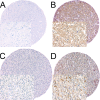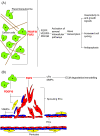Fibroblast growth factor 2 orchestrates angiogenic networking in non-GIST STS patients
- PMID: 21733164
- PMCID: PMC3141498
- DOI: 10.1186/1479-5876-9-104
Fibroblast growth factor 2 orchestrates angiogenic networking in non-GIST STS patients
Abstract
Background: Non-gastrointestinal stromal tumor soft-tissue sarcomas (non-GIST STSs) constitute a heterogeneous group of tumors with poor prognosis. Fibroblast growth factor 2 (FGF2) and fibroblast growth factor receptor-1 (FGFR-1), in close interplay with platelet-derived growth factor-B (PDGF-B) and vascular endothelial growth factor receptor-3 (VEGFR-3), are strongly involved in angiogenesis. This study investigates the prognostic impact of FGF2 and FGFR-1 and explores the impact of their co-expression with PDGF-B and VEGFR-3 in widely resected tumors from non-GIST STS patients.
Methods: Tumor samples from 108 non-GIST STS patients were obtained and tissue microarrays were constructed for each specimen. Immunohistochemistry was used to evaluate the expressions of FGF-2, FGFR-1, PDGF-B and VEGFR-3.
Results: In the multivariate analysis, high expression of FGF2 (P = 0.024, HR = 2.2, 95% CI 1.1-4.4) and the co-expressions of FGF2 & PDGF-B (overall; P = 0.007, intermediate; P = 0.013, HR = 3.6, 95% CI = 1.3-9.7, high; P = 0.002, HR = 6.0, 95% CI = 2.0-18.1) and FGF2 & VEGFR-3 (overall; P = 0.050, intermediate; P = 0.058, HR = 2.0, 95% CI = 0.98-4.1, high; P = 0.028, HR = 2.6, 95% CI = 1.1-6.0) were significant independent prognostic indicators of poor disease-specific survival.
Conclusion: FGF2, alone or in co-expression with PDGF-B and VEGFR-3, is a significant independent negative prognosticator in widely resected non-GIST STS patients.
Figures



Similar articles
-
Prognostic impact of fibroblast growth factor 2 in non-small cell lung cancer: coexpression with VEGFR-3 and PDGF-B predicts poor survival.J Thorac Oncol. 2009 May;4(5):578-85. doi: 10.1097/JTO.0b013e31819f2e38. J Thorac Oncol. 2009. PMID: 19318994
-
Profiling of VEGFs and VEGFRs as prognostic factors in soft tissue sarcoma: VEGFR-3 is an independent predictor of poor prognosis.PLoS One. 2010 Dec 14;5(12):e15368. doi: 10.1371/journal.pone.0015368. PLoS One. 2010. PMID: 21179485 Free PMC article.
-
Co-expression of PDGF-B and VEGFR-3 strongly correlates with lymph node metastasis and poor survival in non-small-cell lung cancer.Ann Oncol. 2010 Feb;21(2):223-231. doi: 10.1093/annonc/mdp296. Epub 2009 Jul 23. Ann Oncol. 2010. PMID: 19628565
-
Targeted therapy in sarcomas other than GIST tumors.J Surg Oncol. 2015 Apr;111(5):632-40. doi: 10.1002/jso.23802. Epub 2014 Oct 20. J Surg Oncol. 2015. PMID: 25330750 Free PMC article. Review.
-
The angiogenic asset of soft tissue sarcomas: a new tool to discover new therapeutic targets.Biosci Rep. 2014 Nov 4;34(6):e00147. doi: 10.1042/BSR20140075. Biosci Rep. 2014. PMID: 25236925 Free PMC article. Review.
Cited by
-
Histology-Specific Uses of Tyrosine Kinase Inhibitors in Non-gastrointestinal Stromal Tumor Sarcomas.Curr Treat Options Oncol. 2016 Feb;17(2):11. doi: 10.1007/s11864-015-0382-0. Curr Treat Options Oncol. 2016. PMID: 26931561
-
FGFR2 is overexpressed in myxoid liposarcoma and inhibition of FGFR signaling impairs tumor growth in vitro.Oncotarget. 2015 Aug 21;6(24):20215-30. doi: 10.18632/oncotarget.4046. Oncotarget. 2015. PMID: 26036639 Free PMC article.
-
Regorafenib for the Treatment of Sarcoma.Curr Treat Options Oncol. 2022 Nov;23(11):1477-1502. doi: 10.1007/s11864-022-00990-0. Epub 2022 Sep 30. Curr Treat Options Oncol. 2022. PMID: 36178573 Review.
-
Smad signal pathway regulates angiogenesis via endothelial cell in an adipose-derived stromal cell/endothelial cell co-culture, 3D gel model.Mol Cell Biochem. 2016 Jan;412(1-2):281-8. doi: 10.1007/s11010-015-2634-5. Epub 2015 Dec 22. Mol Cell Biochem. 2016. PMID: 26694166
-
Pazopanib in sarcomas: expanding the PALETTE.Curr Opin Oncol. 2013 Jul;25(4):373-8. doi: 10.1097/CCO.0b013e3283622d3a. Curr Opin Oncol. 2013. PMID: 23666473 Free PMC article. Review.
References
-
- Fletcher CDM, Unni KK, Mertens F. Pathology and genetics of tumours of soft tissue and bone. Lyon: IARC Press; 2002.
MeSH terms
Substances
LinkOut - more resources
Full Text Sources
Medical
Miscellaneous

